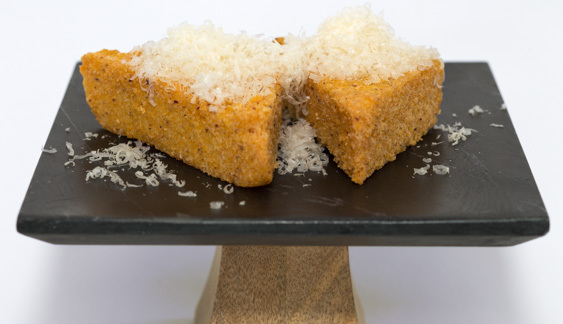Crisp Deep-Fried Polenta Integrale

introduction
We’ve explored a number of vehicles for delivering a crisp burnish to poured polenta: the grill, the broiler, ye olde fry pan. All were delicious. But this particular method, deep-frying, and this particular polenta, coarse integrale, blew the entire world of polenta into a distant galaxy. All-out immersion in hot fat rendered polenta wedges uniformly crispy-crunchy about their entire surface and begat an explosion of toasted corn flavor. The interior of the wedge? Hot, soulful corn mush.
Make a great thing even better by serving each fried wedge with a dab or two of Piperade.
Cooking Remarks
The best way to stir this polenta during simmering is to alternate between whisk and wooden spoon: use a whisk to bring the cornmeal slurry up to its first wave of thickening and to prevent possible lumps down the road, and then use a wooden spoon to ensure that the bottom of the pan stays smooth, with no stickage.
The polenta wedges must be patted dry before frying, and the fat must be 400 degrees before they are dropped in.
equipment mise en place
For this recipe, you will need a pastry brush; an 8-inch square glass baking dish; a teakettle; a large heavy-bottomed saucepan; a whisk; a wooden spoon; an offset icing spatula or spoon; parchment paper; a cutting board; a small offset spatula; two rimmed baking sheets; a chef’s knife; a large, heavy-bottomed Dutch oven (preferably enameled cast iron); an instant-read or deep-fry thermometer; a wire skimmer; and a metal spatula.
-
-
Olive oil for the greasing baking dish
-
Spring or filtered water
-
9ounces (1½ cups) Anson Mills Artisan Handmade Coarse Rustic Polenta Integrale
-
2teaspoons fine sea salt
-
½teaspoon freshly ground black pepper
-
1ounce (2 tablespoons) unsalted butter
-
About 2½ quarts peanut oil
-
Parmesan Reggiano for serving
-
-
Brush an 8-inch square glass baking dish with olive oil and set it aside. Bring about 1 cup of water to a boil in a teakettle and remove from the heat.
-
Place the polenta and 6 cups of water water in a large heavy-bottomed saucepan and whisk to combine. Set the pan over medium-high heat and bring to a simmer, whisking constantly until the first starch takes hold, 5 to 8 minutes. Turn down the heat to a low setting, position the pot lid so that it is slightly ajar, and cook, stirring frequently, until the grains are soft but thick enough to hold their shape on a spoon, about 45 minutes. If the polenta becomes thick before the grains are tender, return the water in the kettle to a boil, whisk in about ¼ cup of water, and continue to cook. When the polenta is finished (fig. 2.1), whisk in the salt, pepper, and butter.
-
Turn the polenta into the prepared baking dish and smooth the surface with an offset spatula or spoon (fig. 3.1). Cover flush with plastic wrap and refrigerate until completely chilled, at least 4 hours or up to overnight.
-
Cover a cutting board with parchment paper. Run a small offset spatula between the baking pan and the polenta on all four sides, pressing the spatula against the sides of the dish in order to not mar or slice into the polenta. Invert the dish onto the cutting board and lift off the dish. If the polenta does not immediately release, place a hot, wet towel against the bottom (momentarily the top) of the baking dish to loosen the polenta, and then remove the dish. Using a chef’s knife, score a cross on the surface of the polenta to create four 4-inch squares, and then score an X from corner to corner to create 8 triangles. Cut all the way through the score marks (fig. 4.1). Pat the polenta wedges dry on all sides with paper towels.
-
Adjust an oven rack to the middle position and heat the oven to 250 degrees. Line a rimmed baking sheet with parchment paper and slide it onto the oven rack. Line a second rimmed baking sheet with a triple thickness of paper toweling and set it to the side of the stove.
-
Pour the oil into a large, heavy-bottomed Dutch oven (preferably enameled cast iron); it should come to a depth of about 4 inches. Warm the oil over medium-high heat until it registers 400 degrees on an instant-read or deep-fry thermometer. Slide 4 polenta wedges into the hot oil (fig. 6.1), raise the heat to high to compensate for a drop in temperature when the polenta goes in, and check the temperature periodically to make sure it is maintained. Fry the polenta until it is deeply burnished on all surfaces, 5 to 7 minutes. Using a wire skimmer, transfer the polenta to the paper towel–lined baking sheet. Drain well, and then use a metal spatula to transfer the pieces to the baking sheet in the oven. Allow the oil to come back up to temperature before frying the remaining 4 polenta wedges. Drain them on the paper towel–lined baking sheet when they are done (fig. 6.2). Serve hot, with Parmesan Reggiano grated generously on top.
-
-
2.1

-
-
-
3.1

-
-
-
4.1

-
-
-
6.1

-
6.2

-